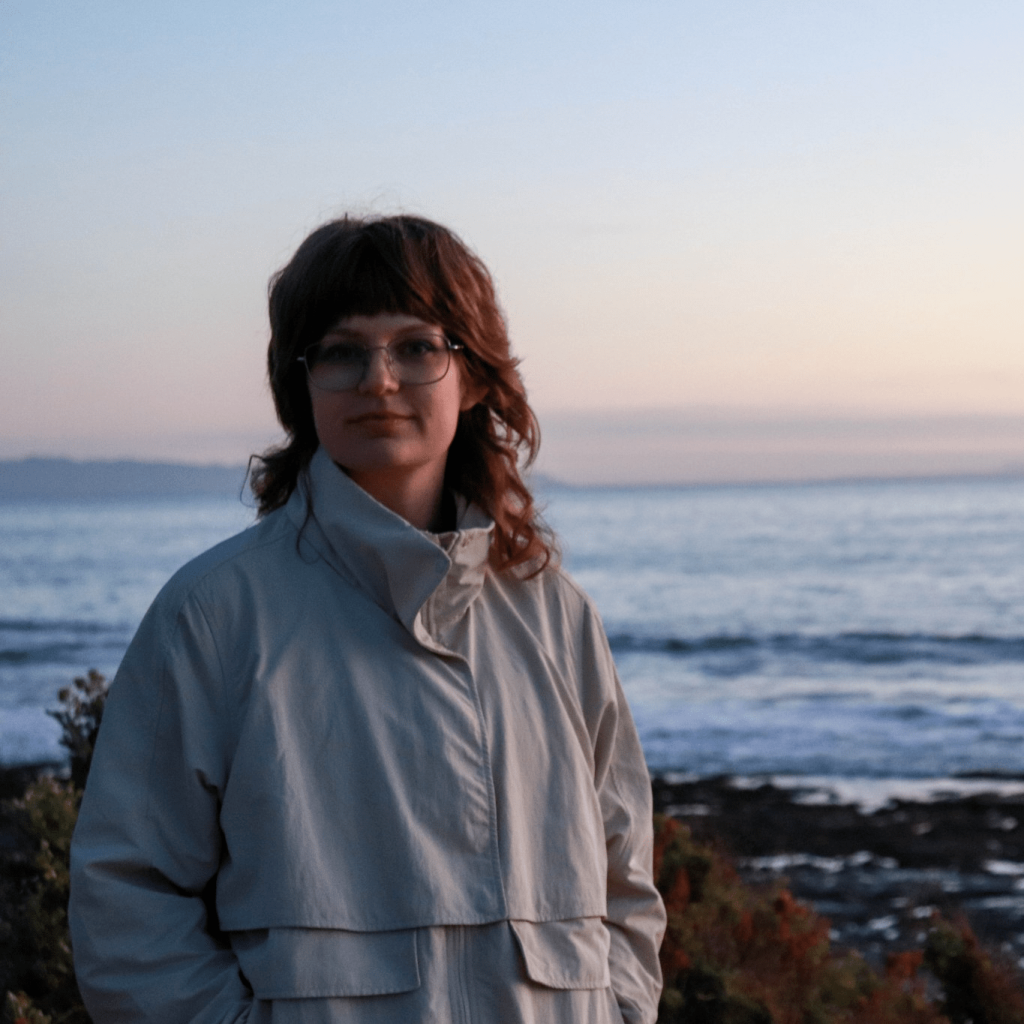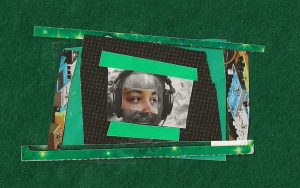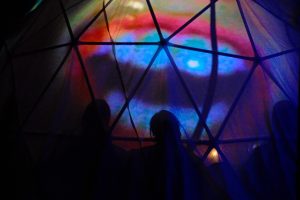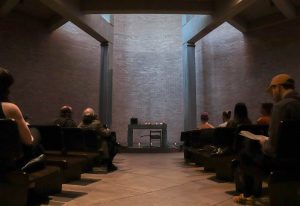A crowd of creatives huddled in the small gallery space, The Plan, on a Friday evening with one aim: to make noise. Audience members were encouraged to produce noise that night as the central focus of the exhibition, Soft Noise, through clanging cymbals, various chimes, basses, electronic hums, hissing, and scratches. The exhibition’s constellation of artists investigate noise as a historically “unwanted branch of sound”1 through questions like, “what constitutes as noisy? How do we think about noise as an aberrant to sound? What possibilities might there be in thinking ‘noisily’? And lastly, how might we go about emasculating the aesthetic domain of noise and its makers?”2
At The Plan, visitors hear the exhibition before they see it. The most audible is Ro(b)//ert Lundberg’s In Passing, in the right corner of the gallery. In Passing is a salmon pillow with orange horizontal lines that rests on the ground and projects ambiguous industrial sounds. A cord peaks from underneath the pillow and stretches across the wood floor—where a body would lay—and is plugged into the nearest socket. The pillow that lays on top of the sound conceals it or acts as a buffer for the creaking and haunting mechanical echo. Here, noise is not an isolated audible phenomenon but also spatial and visual.
Experiencing In Passing destabilizes auditory perception. A pillow, an item typically representing domesticity, is combined with grand industrial sounds played from underneath it, blurring the conception of where we expect sounds to belong. The pillow offers us comfort and respite, shielding us from the exterior noise and chaos of the outside. Instead, the source of noise is hidden underneath the pillow. In Passing displays noise as a place-based concept through the conflict of our expectations.3
While noise is not an objective fact, current conceptions about noise—including what noise is, who can make it, and where it belongs—can be traced back to the eighteenth century.4 In researching the history of noise, Brandon Labelle and Paul Hegarty both explain how abatement legislation5 has particularly played a leading role in establishing what we conceive of as noise as a sound deemed unwanted. Noise has less to do with noise levels and more to do with judgments about sounds “other” people make and what is deemed to disturb. As Labelle points out, acoustic politics of space equated noisiness with ”the other,” always “breaking commonality.”6 For example, Labelle, along with the scholar R. Murray Schafer, report that the “types of noise that attracted the most complaint were the sounds made by the poorest citizens, especially sounds made by popular entertainers and low-profit traders.”7 As a result, “quiet” became attainable only by those who could afford it and “silence” became a homogenizing ideal.8
Noise is a negativity defined in relation to what it is not.9 The work of Cathy Hsiao exploits this aspect of noise in her auto-ethnographic installation, Lost in Translation. Noise is used as a disruptor and a disturbance to transgress societal disciplining within the acoustic politics between Taiwan and China. Lost in Translation includes a cylinder speaker and a flat metal sculpture of a Chinese character that translates to “Blue” which expands on a previous series by Hsiao called What Flies but never Lands specifically made to question the reality of surveillance and resistance through the internet.10 The speaker is hung at eye level and its outer texture references the ornamental round studs of the Forbidden City doors in Beijing. The speaker plays “Green Island Serenade” for 2 hours and 37 minutes; the song gets progressively slower and slower and the high pitched voice becomes lower and lower until it finally stops.11
“Green Island Serenade” is “one of the earliest songs from a Taiwan-based singer to achieve widespread popularity among other overseas Chinese communities,” but it also has a long political dispute of authorship and intent. One historical account claims that the professional musician, Pan Ying-chieh and Chow Lan-ping composed the song for the film which popularized it. The other account claims that the political prisoners Gao Yudang and Wang Bo-wen wrote the song while they were prisoners at the Green Island, a place for exiling prisoners during the late 1940s during the single party rule of the Chinese Nationalist Party, Taiwan’s Kuomintang.13 Slightly below the speaker and to the right is a small black and white photo of Green Island and above it is the journal White Fungus, an arts and culture magazine based in Taiwan. The journal is opened up to the article, “Wasteland Utopia,” by music writer Jeph Lo who describes witnessing the emergence of noise music in Taiwan following the lifting of martial law in 1987.14 There are many historical threads to follow in Hsiao’s Lost in Translation, but ultimately, Hsiao conveys a story of complex power dynamics around a cultural history of sound posing noise as a tool for acoustic emancipation and cultural independence.
Video: Documentation of Soft Noise Closing Performance at The Plan featuring Madeleine Aguilar, Michelle Chung, and visitors playing Mobile Music Maker III on December 11, 2022. Video documentation and editing by Matt Plain.
Breaking the ambient atmosphere of the gallery into an intuitive site of musical intervention is Madeleine Aguilar’s Mobile Music Maker iii, which explores the social and musical perspectives of noise. Placed slightly off center in the back of the gallery, the piece is an arrangement of collected items that have the ability to produce sound, including handmade chimes, a drywall scraper, rulers, wash bucket, found wood, a keyboard, a synth. As an interactive piece, anyone, regardless of their musical ability, can play Mobile Music Maker iii, fitting as many as eight players at a time. Depending on its participants, Mobile Music Maker iii has the potential to create familiar musical narratives, semantics, sequences, or further exploit its non-traditional nature and resist common musical structuring or organization all together existing as pure reckless and glorious noise. Mobile Music Maker iii reminds us, as the scholar Paul Hegarty wrote, that “the acoustical event is also a social one’s(x) — it is not just the interaction of human subjects with an object world; it is also interactivity as society.”15 Mobile Music Maker iii reminds us that noise does not occur in isolation but in relation to society, space, and sound.
Noise is constantly present and, while some noises are deemed unpleasant, others are welcome. For instance, noise as it appears, artwork Teenage Lament ‘76 (30 Minutes to Memory) by Academy Records16 is very much desired. Teenage Lament ‘76 is an audio cassette and cassette player that hangs on the wall at eye level. It highlights the materiality of sound and its storage. The analog device invites noise into the recording, unlike digital recordings which aim to eliminate as much background noise as possible. In a sound slightly muffled and distorted, the cassette plays an audio assemblage of conversations and songs that switch every few minutes. The content of the piece is reminiscent of a television playing in the background. Teenage Lament ‘76 brings attention to the materiality of the recording device and how we now feel a cultural nostalgia or a fondness for a noise when listening to it from devices like the cassette player. Teenage Lament ‘76 also explains a logic that may be useful in unpacking how we conceive of noise as unwanted. The noise from the audio cassette is familiar, allowing noise to be welcome. Noise associated with judgment about something unfamiliar is “noisy.” Noise is the loss of controlled listening or a failure of adequate hearing.17
Soft Noise included many silent works in the exhibition, including Willa Smart, Elena Ailes and Peach Miller. Miller describes their use of silence particularly well in the small notes in the exhibition text:
“Maybe we need to be hearing more, wherein everything screams with equal loudness. So that we may all be at the mercy of noise, and in it find power, or peace. And in that power and peace, we find the will to say what we mean to say with the confidence that we will gladly and boldly be heard.”
As much as the artworks in Soft Noise ask us to think about noise, they emphasize listening. Noise occurs in a framework of unfamiliar excess that overwhelms listening. The scholar Gascia Ouzounian writes, “Auditory spaces have never been empty or neutral, but instead have always been replete with social, cultural, and political meanings.”18 As the works in Soft Noise reveal and amplify, noise is spatial, social, and visual. Ultimately, Soft Noise urges us to hear noise differently.
Soft Noise was curated by Chris Reeves and Aaron Walker at The Plan, a new gallery run by Philip Spangler, and included artwork by Elena Ailes, Madeleine Aguilar, Cathy Hsiao, Ro Lundberg, Peach Miller, Eileen Mueller, Paige Alice Naylor, Betsy Odom, Academy Records, and Willa Smart.
Works Cited:
1 Chris Reeves and Aaron Walker, “Soft Noise,” curatorial statement.
2 Ibid.
3 Brandon Labelle, Acoustic territories: sound culture and everyday life, (London and New York: Continuum International Publishing Group, 2010), 47.
4 Labelle, 16.
5 This claim is based on the following resources: Brandon Labelle, Acoustic territories: sound culture and everyday life, (London, New York: Continum International Publishing Group, 2010) and Paul Hegarty, Noise/Music: A History, (London and New York: Bloomsbury, 2007).
The earliest evidence of acts I could find was the “Nuisances and Annoyances in the cities of London and Westminster of 1871.” For more about general Abatement laws, see here. To learn more about Abatement in the United States, see the noise pollution and abatement act of 1972.
6 Labelle, 55.
7 Labelle, 16-17.
8 Ibid.
9 Paul Hegarty, Noise/Music: A History, (New York & London: Bloomsbury, 2007), 5.
10 Artist’s website, accessed January 29, 2023, https://lvl3official.com/cathy-hsiao/.
11 You can listen to “Green Island Serenade” on Hsiao’s website: https://cathyhsiao.info/
12 “Green Island Serenade,” Wikipedia, https://en.wikipedia.org/wiki/Green_Island_Serenade.
13 Ibid.
14 Jeph Lo, “Wasteland Utopia: The Liberation of Sound in Post–Martial Law Taiwan” Full Stop, https://www.full-stop.net/2019/03/18/blog/jeph-lo/wasteland-utopia-the-liberation-of-sound-in-post-martial-law-taiwan/
15 Hegarty, 171.
16 Academy Records is the art practice of Stephen Lacy.
17 Hegarty, 5.
18 Gascia Ouzounian, Stereophonica: Sound and Space in Science, Technology, and the Arts, (Cambridge and London: MIT Press, 2020), 16.

About the Author: Livy Onalee Snyder is based in Chicago. She graduated from the University of Chicago with a Masters in Humanities. She has published in Sixty Inches From Center, Ruckus, Newcity, Tiltwest, Denver Art Review: Inquiry and Analysis (DARIA) and interviewed artists for Black Cube Nomadic Museum. Currently, she holds a position at punctum books and advocates for Open Access. Read Livy’s writing for Sixty here.






